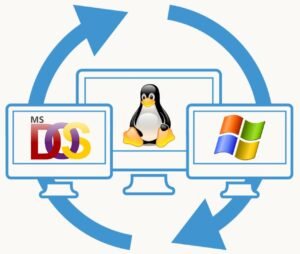Table of Contents
Development Platforms for Multimedia
When evaluating a platform for multimedia delivery, one must take into account how well that particular computing environment implements and supports the technologies that make multimedia computing possible. Hardware support, however, is not necessarily the most important criterion. Other factors, including the availability of authoring software and the installed base of computing equipment within the user’s environment.

1. DOS (Disk Operating System)
The current minimum specifications for the DOS platform have been established by the Multimedia PC Marketing Council as a 486SX-25 with 4 MB of RAM (8 recommended), 160 MB hard drive, standard VGA, 16 bit sound, and a 300 kB/s CD-ROM drive. As much of the DOS based multimedia software runs under Windows, additional RAM would likely be required beyond the recommended 8 MB, bringing the price of a basic machine somewhat higher than the basic Macintosh machine.
Macintosh platform promised a graphical interface and a commitment to the easy inclusion of audio, video, animation and other graphical images, particularly through Apple’s support for multimedia and the required hardware. The IBM/MS-DOS platform, pre Windows, still in 1989, did not appear to be as advanced graphically.
DOS is a text-based operating system from early computing. Multimedia development was very limited but included basic tools:
Tool/Platform | Function |
Turbo C / C++ | Console-based programming with basic graphics via graphics.h |
AutoCAD (DOS versions) | Simple design and modeling |
Basic Sound/Graphics Drivers | Used for audio-visual experiments in early development |
Limitations: No GUI, limited color/audio support, primitive compared to modern platforms.
2. Windows
The release of Microsoft’s Video for Windows in 1992 provided a foundation for bringing digital video to the DOS platform. Video for Windows makes it possible to play digital video sequences on any computer running Windows 3.1 without the need for additional hardware. The package also includes a utility for capturing video from an external source, such as a video camera or a video cassette recorder, when the development machine is equipped with both a video capture board and a digital sound card to handle the capture process.
Windows is the most widely used OS for multimedia development, offering powerful software platforms.
Platform | Use Case |
Adobe Creative Cloud | Industry-standard for image, video, audio, animation |
Microsoft Visual Studio | Coding multimedia applications (.NET, C#, VB) |
Unity / Unreal Engine | Game development and interactive multimedia |
CorelDRAW / Photoshop | Graphics design |
Audacity / Adobe Audition | Audio recording and editing |
PowerPoint / Captivate | Multimedia presentations and e-learning |
Strength: Rich GUI, vast developer support, and compatibility with multimedia hardware.
3. Linux
Linux is widely used in open-source and server-side multimedia development.
Platform | Use Case |
Blender | 3D modeling and animation |
GIMP | Image editing (open-source alternative to Photoshop) |
Kdenlive / OpenShot | Video editing |
Audacity | Audio editing |
FFmpeg | Multimedia framework for processing video/audio |
GTK / Qt | Developing GUI-based multimedia apps |
Strength: Lightweight, open-source tools, scripting, and batch processing.
You May Like to Browers More




